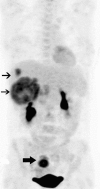PET/CT imaging in the diagnosis, staging, and follow-up of colorectal cancer
- PMID: 18852081
- PMCID: PMC2582503
- DOI: 10.1102/1470-7330.2008.9009
PET/CT imaging in the diagnosis, staging, and follow-up of colorectal cancer
Abstract
Colorectal cancer is a common malignancy that afflicts many in the western world. Imaging studies are frequently used to evaluate patients in the screening, staging and surveillance of colorectal cancer. Cross sectional imaging studies such as ultrasound, computed tomography and magnetic resonance imaging provide anatomic and morphologic information about tumor and patterns of spread. Positron emission tomography (PET) differs in that it provides information about tumor metabolism.[(18)F]Fluorodeoxyglucose PET has been clinically used for the evaluation of patients with a wide variety of cancers since most malignancies, including colorectal cancer, typically show increased glucose metabolism. This review present the positron emission tomography/computed tomography imaging findings that may be encountered in the diagnosis, staging and follow-up of patients with colorectal cancer.
Figures




Similar articles
-
A prospective diagnostic accuracy study of 18F-fluorodeoxyglucose positron emission tomography/computed tomography, multidetector row computed tomography, and magnetic resonance imaging in primary diagnosis and staging of pancreatic cancer.Ann Surg. 2009 Dec;250(6):957-63. doi: 10.1097/SLA.0b013e3181b2fafa. Ann Surg. 2009. PMID: 19687736
-
PET/CT for the staging and follow-up of patients with malignancies.Eur J Radiol. 2009 Jun;70(3):382-92. doi: 10.1016/j.ejrad.2009.03.051. Epub 2009 Apr 29. Eur J Radiol. 2009. PMID: 19406595 Review.
-
Diagnostic accuracy of serial CT/magnetic resonance imaging review vs. positron emission tomography/CT in colorectal cancer patients with suspected and known recurrence.Dis Colon Rectum. 2009 Feb;52(2):253-9. doi: 10.1007/DCR.0b013e31819d11e6. Dis Colon Rectum. 2009. PMID: 19279420
-
Gadoxetate disodium-enhanced magnetic resonance imaging versus contrast-enhanced 18F-fluorodeoxyglucose positron emission tomography/computed tomography for the detection of colorectal liver metastases.Invest Radiol. 2011 Sep;46(9):548-55. doi: 10.1097/RLI.0b013e31821a2163. Invest Radiol. 2011. PMID: 21577131
-
Preoperative intrathoracic lymph node staging in patients with non-small-cell lung cancer: accuracy of integrated positron emission tomography and computed tomography.Eur J Cardiothorac Surg. 2009 Sep;36(3):440-5. doi: 10.1016/j.ejcts.2009.04.003. Epub 2009 May 22. Eur J Cardiothorac Surg. 2009. PMID: 19464906 Review.
Cited by
-
Peptide PET Imaging: A Review of Recent Developments and a Look at the Future of Radiometal-Labeled Peptides in Medicine.Chem Biomed Imaging. 2024 Aug 23;2(9):615-630. doi: 10.1021/cbmi.4c00030. eCollection 2024 Sep 23. Chem Biomed Imaging. 2024. PMID: 39474267 Free PMC article. Review.
-
FDG-PET/CT Is Superior to Enhanced CT in Detecting Recurrent Subcentimeter Lesions in the Abdominopelvic Cavity in Colorectal Cancer.Nucl Med Mol Imaging. 2011 Jun;45(2):132-8. doi: 10.1007/s13139-011-0082-z. Epub 2011 Apr 20. Nucl Med Mol Imaging. 2011. PMID: 24899992 Free PMC article.
-
[Importance of PET/CT for imaging of colorectal cancer].Radiologe. 2012 Jun;52(6):529-36. doi: 10.1007/s00117-011-2284-x. Radiologe. 2012. PMID: 22618625 German.
-
PET/CT and brain MRI role in staging NSCLC: prospective assessment of the accuracy, reliability and cost-effectiveness.Lung Cancer Manag. 2018 May 31;7(2):LMT02. doi: 10.2217/lmt-2018-0008. eCollection 2018 Jun. Lung Cancer Manag. 2018. PMID: 30643581 Free PMC article.
-
Advancements and Challenges in the Image-Based Diagnosis of Lung and Colon Cancer: A Comprehensive Review.Cancer Inform. 2024 Oct 16;23:11769351241290608. doi: 10.1177/11769351241290608. eCollection 2024. Cancer Inform. 2024. PMID: 39483315 Free PMC article. Review.
References
-
- Jemal A, Siegel R, Ward E, et al. Cancer statistics 2008. CA Cancer J Clin. 2008;58:71–96. - PubMed
-
- Gore RM. Colorectal cancer: clinical and pathologic features. Radiol Clin North Am. 1997;35:404–29. - PubMed
-
- Morson BC. Evolution of cancer of the colon and rectum. Cancer. 1974;34:845–9. - PubMed
-
- Stryker SJ, Wolff BG, Culp CE, Libbe SD, Ilstrup DM, MacCarty RL. Natural history of untreated colonic polyps. Gastroenterology. 1987;93:1009–13. - PubMed
-
- Nakada K, Brown RS, Fisher SJ, et al. Histological localization of tritiated FDG in the GI tract: an autoradiographic study. J Nucl Med. 2001;42(suppl):25.
Publication types
MeSH terms
Substances
LinkOut - more resources
Full Text Sources
Medical
